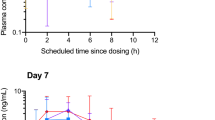Summary
The terminal elimination half-life of Δ1-tetrahydrocannabinol (Δ1-THC) was investigated in eight men who were heavy users of marijuana. A stable isotope assay, following smoking deuteriumlabeled Δ1-THC, was used to determine plasma concentrations. In two additional users plasma levels were followed after administration of unlabeled Δ1-THC. The subjects were asked to smoke a “loading dose” of 56 mg Δ1-THC during two days and then abstain from all marijuana use for 4 weeks.
The pharmacokinetic behavior was consistent with a multicompartment model with a mean plasma elimination half-life of Δ1-THC of 4.3 days when concentrations were followed for 10–15 days after smoking. In the two subjects with detectable plasma levels during 4 weeks, half-lives of 9.6 and 12.6 days was obtained.
Similar content being viewed by others
References
Agurell S, Halldin M, Lindgren JE, Ohlsson A, Widman M, Gillespie H, Hollister LE (1986) Pharmacokinetics and metabolism of Δ1-tetrahydrocannabinol and other cannabinoids with emphasis on man. Pharmacol Rev 38: 21–43
Harvey DJ (1984) Chemistry, metabolism and pharmacokinetics of the cannabinoids. In: Nahas GG (ed) Marijuana in science and medicine. Raven Press, New York, pp 37–107
Ohlsson A, Lindgren JE, Wahlén A, Agurell S, Hollister LE, Gillespie HK (1982) Single dose kinetics of deuterium-labelled Δ1-tetrahydrocannabinol in heavy and light cannabis users. Biomed Mass Spectrom 9: 6–10
Barnett G, Chiang CWN, Perez-Reyes M, Owens SM (1982) Kinetic study of smoking marijuana. J Pharmacokinet Biopharm 10: 495–506
Wall ME, Sadler BM, Brine D, Taylor H, Perez-Reyes M (1983) Metabolism, disposition, and kinetics of Δ9-tetrahydrocannabinol in men and women. Clin Pharmacol Ther 34: 352–363
Lindgren JE, Ohlsson A, Agurell S, Hollister L, Gillespie H (1982) Clinical effects and plasma levels of Δ9-tetrahydrocannabinol (Δ9-THC) in heavy and light users ofCannabis. Psychopharmacology 74: 208–212
Lemberger L (1973) Tetrahydrocannabinol metabolism in man. Drug Metab Dispos 1: 462–468
Hunt CA, Jones RT (1980) Tolerance and disposition of tetrahydrocannabinol in man. J Pharmacol Exp Ther 215: 35–44
Agurell SL, Hollister LE (1986) Pharmacokinetics and metabolism of Δ9-tetrahydrocannabinol: Relations to effects in man. Alcohol Drugs Driving 2: 61–79
Johansson E, Agurell S, Hollister LE, Halldin MM (1988) Prolonged apparent half-life of Δ1-tetrahydrocannabinol in plasma of chronic marijuana users. J Pharm Pharmacol 40: 374–375
Johansson E, Norén K, Sjövall J, Halldin MM (1989) Determination of Δ1-Tetrahydrocannabinol in human fat biopsies by gas chromatography-mass spectrometry. Biomed Chromatogr 3: 35–38
Cridland JS, Rottanburg D, Robins AH (1983) Apparent half-life of excretion of cannabinoids in man. Human Toxicol 2: 641–644
Ohlsson A, Lindgren JE, Leander K, Agurell S (1976) Detection and quantification of THC in blood plasma. In: Willette RE (ed) Cannabinoid assays in humans. NIDA Research Monograph 7. NIDA, Rockville, pp 48–62
Agurell S, Leander K (1971) Stability, transfer, and absorption of cannabinoid constituents ofCannabis (Hashish) during smoking. Acta Pharm Suec 8: 391–402
Ohlsson A, Agurell S, Lindgren JE, Leander K (1979) Improvement of the mass fragmentographic technique for quantification of tetrahydrocannabinol in human blood plasma. In: Vinson JA (ed) Cannabinoid analysis in physiological fluids. ACS Symposium Series 98. Washington DC, pp 73–79
Peck CC, Beal SL, Scheiner LB, Nichols AI (1984) Extended least square non-linear regression: A possible solution to the problem in analysis of individual pharmacokinetic data. J Pharmacokinet Biopharm 12: 545–558
Leuschner JTA, Harvey DJ, Bullingham RES, Paton WDM (1986) Pharmacokinetics of Δ9-tetrahydrocannabinol in rabbits following single and multiple intravenous doses. Drug Metab Dispos 14: 230–238
Ellis GM Jr, Mann MA, Judson BE, Schramm NT, Tashehian A (1985) Excretion patterns of cannabinoid metabolites after last use in a group of chronic users. Clin Pharmacol Ther 38: 562–578
Dackis CA, Pottash ALC, Annitto W, Gold MS (1982) Persistence of urinary marijuana levels after supervised abstinence. Am J Psychiatry 139: 1196–1198
Author information
Authors and Affiliations
Rights and permissions
About this article
Cite this article
Johansson, E., Halldin, M.M., Agurell, S. et al. Terminal elimination plasma half-life of Δ1-tetrahydrocannabinol (Δ1-THC) in heavy users of marijuana. Eur J Clin Pharmacol 37, 273–277 (1989). https://doi.org/10.1007/BF00679783
Received:
Accepted:
Issue Date:
DOI: https://doi.org/10.1007/BF00679783




